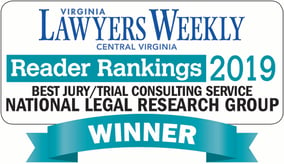May 16, 2017
Jeffrey T. Frederick, Ph.D.

So far in the Tips series, the focus has been on setting the stage for effective voir dire by (a) treating voir dire as a conversation with jurors (Tip 1); (b) using techniques that help jurors feel comfortable with speaking in court (Tip 2); and capitalizing on the initial hand-raising technique to encourage participation in the voir dire process (Tip 3). I turn now to the nature of the questions themselves, in particular open-ended versus closed-ended questions. While both of these formats have their place in a well-conducted voir dire, one format, open-ended questions, deserves special attention. Knowing how and when to use open-ended questions can vastly improve your effectiveness in jury selection. (Click here to see a short video for this tip.)
Open-Ended v. Close-Ended Questions
A major distinction in the phrasing of questions is whether the question is phrased in an open-ended versus closed-ended format. Open-ended questions are those questions that do not provide the answer within the question itself. These questions are often prefaced with phrases such as, “What do you think/feel/believe about . . .”; “Why?”; “In what way . . .”. These questions focus jurors’ attention on the topic, yet leave it to them to formulate an answer. The following are examples of the open-ended approach:
“How do you feel about patients bringing lawsuits against doctors over the treatment they received?”
“What would your impression be of defendants in criminal trials who do not testify in their own defense?”
“What is your opinion of the law that allows for money damages designed to punish a defendant?”
Closed-ended questions are those that provide the response options or “answers” within the question itself. They can explicitly provide the potential answers (e.g., “Do you agree or disagree . . .”) or the answers are implied by the phrasing of the question (e.g., Do you agree that . . .), where the implied answer is “yes” or “no.” Consider the following examples of the topics addressed above:
“Do you believe that patients should be able to sue their doctors over the treatment they receive?”
“Do you believe that defendants in criminal trials who do not testify in their own defense are probably guilty?”
“Do you agree or disagree with the law that allows for money damages designed to punish a defendant?”
Advantages of open-ended questions
While both question formats are useful, open-ended questions have several advantages over closed-ended questions.
Open-Ended Questions
Increased Information Disclosure
By not explicitly or implicitly providing the possible answers, open-ended questions force jurors to consider the question and come up with their own answer. Not only do you hear the words chosen and how the juror articulates his or her answer, you also can observe the jurors’ nonverbal communication as he or she reflects on the question and expresses the resulting answer. The process evoked by open-ended questions provides for a potentially richer answer in terms of both verbal and nonverbal communication.
Greater Consideration of the Issue
Open-ended questions force jurors to more fully consider an issue since they will be called upon to articulate their answer. Simply saying yes or no or indicating agreement or disagreement with a position does not necessitate serious consideration. However, having to express an opinion or viewpoint in their own words forces jurors to consider the topic and their answer more carefully.
Greater Follow-Up Potential
Since open-ended questions do not restrict the answers available to jurors, these questions carry the potential for greater variation in the subsequent answer. Jurors can agree or disagree with a position or viewpoint for a variety of reasons. By asking open-ended questions, the variation in support or opposition to a viewpoint—or even confusion over the question—is more likely revealed. Subsequent follow-up questioning can focus on these subtle differences, resulting in a greater understanding of the jurors’ views on the issue.
Lessening of the Socially Desirable Response Bias
A significant concern in voir dire is that jurors may respond to questions with what they think are the socially “correct” answers (socially desirable response bias), thus reducing the usefulness of their answers. While we will address this bias in our next tip, it is relevant here. Open-ended questioning tends to minimize the socially desirable response bias. By not providing an answer (or clues to possible “correct” answers) within the question itself, open-ended questions force jurors to formulate their own answer uninfluenced by any choices or “hints” provided. The result is a lessening of the socially desirable response bias.
Promotes Greater Involvement in Voir Dire
Open-ended questions require jurors to think and articulate their answers, beyond a simple raising of the hand. When used to explore an issue with a series of jurors, all potential jurors must pay attention and be prepared to answer. Add to this the fact that those who answer gradually become more accustomed to participating in the voir dire process, and you have the potential for a lively and informative conversation with jurors.
Closed-Ended Questions
There are good reasons why closed-ended questions comprise a majority of the questions asked on voir dire. A few of these reasons are as follows:
Collect Information in a Short Period of Time
Closed-ended questions can collect more information over a shorter period of time than can open-ended questions. In group voir dire, closed-ended questions posed to the group can quickly gather information from the panel through jurors raising their hands in response to questions. Even with individual voir dire, questioning using a closed-ended format generally proceeds at a faster pace.
Focus the Nature of Inquiry
Closed-ended questions are particularly good at zeroing in on specific issues. If the key opinions or viewpoints are known and few in number, closed-ended questions can focus the jurors’ attention on these specific opinions and viewpoints, thus refining the quality of information you uncover.
Necessary with Scaled Questions
Closed-ended questions are necessary when using questions that rely on specific scaled responses (e.g., likert scaling or other established scaled items). For example, questions derived from research or personality, social, or political constructs, often have scaled semantic responses (e.g., agree strongly, agree somewhat, disagree somewhat, disagree strongly) or fixed ranges of numerical values (e.g., 1–5). These types of scales require asking the question in a closed-ended fashion so as to be comparable to established research findings.
Judges Are More Familiar with Closed-Ended Questions
Finally, judges are more accustomed to questions being asked in a closed-ended format. Hence, they may be more receptive to a closed-ended versus an open-ended question on the same topic or issue.
Working Together: Open-Ended Questions Enhance Voir Dire
Open-ended questions offer a valuable tool with which you can explore jurors’ views, values, thoughts, and recall of critical information (e.g., pretrial publicity). They can be used effectively as the lead entry into critical topics or issues and provide for a fuller exploration of the jurors’ views, thoughts, and feelings. They can clarify previous answers, e.g., Why is that?” or “In what way?” And they can promote greater involvement in the voir dire process. Used in tandem with closed-ended questions, open-ended questions will help make your overall voir dire more effective.
We will be covering additional tips in the months to come. Check out our introductory two-minute video, Tip 1, Tip 2, Tip 3, and the video for Tip 4.
For more information on voir dire and jury selection, see Mastering Voir Dire and Jury Selection. The fourth edition of this book is scheduled for release by ABA Press in fall 2017!



